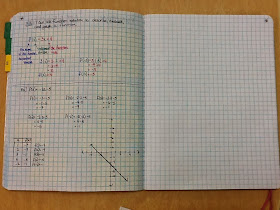I hadn't planned on doing much with integers and order of operations, because I really wanted to stick to the Common Core curriculum. However, as things got going I began to see integer operations really hurting my Topics students. So I decided I really did need to backtrack and do some work with integers. Here are some of the things we've done so far:
Manipulatives: We worked with little pieces to show addition of integers. I made a set of these for each of my students and had them show things like (-5) + 2 and (-4) + 10. I even encouraged them to show me two things that added to 5 or -1. They thought that sounded hard, but once they tried they realized it was easier than they thought it would be. One student even commented "That was easier that it sounded!" Slowly this has lead to drawing + and - signs instead of actually using the pieces, which is just as valuable. I think this aligns very well with what the students have seen from the 7th and 8th grade teachers as far as integer addition.
Integer War: Thanks to Lisa's
post, I decided to play Integer War with my students. I created a
file for them to use to keep track that I thought would help see their progress. I even have a picture of my practicum teacher working with them.
When kids finished their first game instead of asking, "What do we do when we're done?" They were asking, "Can we play again?" And at the end of class in order to get them to clean up I had to say, "I will not write you a pass to second hour. You must leave now." I think this was the best thing for them ever. I even had two students come in during homeroom later to play their 5th game to determine an overall winner.
(With an odd number of students, I got to play a game, too. I could do this because my practicum teacher was walking from group to group ensuring that they were on track. Lucky to have 2 teachers in the room!)
Grudge: Sarah's
post reminded me of Nathan's
post about the most fabulous game ever. I had played it once at the end of last year, but had forgotten about it over the summer. I decided to play with my students. They loved it! And it allows for lots of different challenge questions that all kids try because they want to get someone back. I did have to make a modification this year. The kids were taking FOREVER to choose who to erase an X from and get back to their seats, so I timed them and said that if they weren't back in their seats then I would erase an X from them. This got them scampering back to their seats right away (even if they were out of Xs).
The kids have been asking to play again every day since. I think that is a good sign. I want to find a good balance of when to play and when not to, so I keep telling them I'm waiting for the perfect time.
That's mostly what we've done for now. Next week we will add subtraction of integers and parenthesis! We might play Integer War again with subtraction. I think that would be good for them at some point, but we do need some more instruction and "basic" practice first. I'm looking for good subtraction of integer lessons. Throw any ideas my way :)
-
Kathryn






